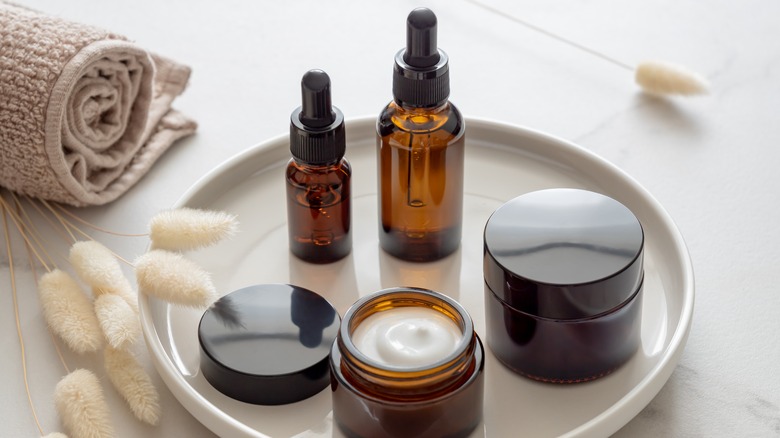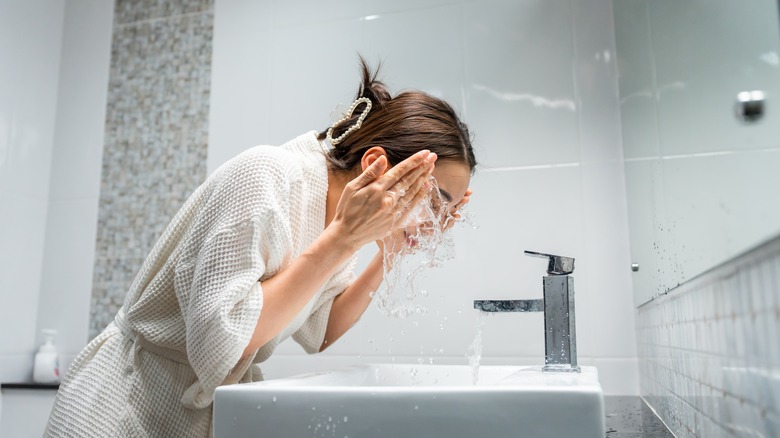Never Change Up The Order Of Your Skincare Routine - Here's Why
Skincare is a science, and like everything else in science, a process must be followed to achieve the best possible results. That's why it's important to follow a skincare routine as the experts designed it and never change the order. When it comes to skincare, routine is your friend!
The skin is the body's largest organ, so it shouldn't be surprising that it needs some maintenance to keep it in tip-top shape. There are specific steps you can take to help overall skin goals, the American Academy of Dermatology Association (AAD) says. Some of those steps shouldn't be too surprising, like wearing ever-important sunscreen, staying away from tanning beds, and not touching your face (that's how germs, oil, and such get on the skin and wreak havoc).
However, AAD also advises simplicity is a person's friend in skincare. In fact, it encourages people to set up and stick to a morning and evening routine involving the basics of cleanser, sunscreen, and moisturizer. If you add other products, don't overdo it because too many anti-aging serums and whatnot can cause the skin to react unfavorably. Since the idea is for the products to make your skin look better, not worse, it's critical to set a routine and stick to it so they can work their magic most effectively.
Apply water-based products before oil-based products
Skincare products are all formulated to achieve different goals. So, it only makes sense that they would have a particular place in the pecking order. Per Health, if they're misapplied, the active ingredients can't do their jobs, rendering much of the process moot. The general rule of thumb is to start with the thinnest treatments and finish with the thickest.
While thickness serves as an easy guideline, Suzan Obagi, M.D., president of the American Academy of Cosmetic Surgery, told Self that a product's composition matters more for application order. "Typically, things that are water-based can be layered on top of [each other]," she explained. "But if you have a cream or an ointment, or a serum that's oil-based, those should be put on afterwards because anything [water-based] you put on top won't get through." So, shoot to apply water-based (typically thinner) products first, then finish with the oil-based (typically thicker) ones for maximum effectiveness.
All of this must follow the use of a cleanser because layering products on top of dirt, sebum, and other grime isn't going to do any good. Working in the correct order also helps the skin have an ideal pH balance. This is vital because if the pH balance is out of whack, then some products will not be able to work as well, Health says. However, according to Self, the pH of the products themselves shouldn't be much of a concern in terms of order unless you have a prescription-strength topical to contend with.
Order is vital for both day and night routines
The ideal skincare routine varies between day and night, and the order of application definitely matters. The American Academy of Dermatology Association (AAD) says that the morning ritual should start with washing the face using a cleanser formulated for your skin, followed by a careful pat dry to preserve some moisture. Then, apply any necessary spot treatment, medication, moisturizer, and sunscreen. Per Harvard Health, a vitamin C serum can also be added before moisturizers because it will help to ward off free radicals like those found in pollution.
Before bed, a few extras can be thrown in. Start with a foaming face wash to wipe away the day, per Elite Dermatology. Then, exfoliate once or twice weekly to eliminate dead skin cells. Next, apply any eye creams and peptides or growth factors for collagen production and to help with cell growth, if needed. After that, use a retinoid product to help with fine lines and other aging concerns (these can be irritating at first, so use them sparingly). Retinoids should always be applied at night. They can make the skin more sensitive to sun damage, and you should never use them simultaneously with AHA or BHAs because they can cause significant irritation. Healthline says to alternate and allow at least 24 hours between them. Then, follow that up with a nighttime moisturizer to help the skin repair itself. You can also add other products like a toner or hydrating mist, essences, serums, face oils, spot treatments, and so on for best results.


